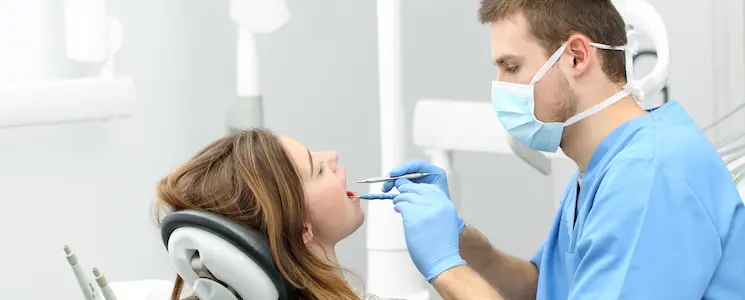Table of Contents
Say Goodbye to Gum Recession with the GUMS Procedure
Intro
Gum recession can be an uncomfortable and embarrassing problem, leading to soreness, sensitivity, and tooth decay. However, there is now a way to say goodbye to receding gums with the GUMS Procedure. The GUMS Procedure, or Grafting Using Miniscrews, is a minimally invasive and highly effective gum grafting technique that offers a quick and effective solution to the problem of gum recession. This blog post will explore the benefits of the GUMS Procedure and discuss how it can be use to treat gum recession.
Understanding Gum Recession
Gum recession, also known as gingival recession, occurs when the gums start to pull away from the teeth, exposing more of the tooth’s surface or even the tooth’s root. This can result in sensitivity, decay, and even tooth loss if not treat. Gum recession can affect people of all ages, but it is more common in people over the age of 40.
Causes of Gum Recession can include genetics, poor oral hygiene habits, aggressive brushing, periodontal disease, hormonal changes, tobacco use, and even certain medications. The most common cause of gum recession is periodontal disease, an infection of the gum tissue.
Consequences of gum recession are not only cosmetic, but they can also be detrimental to your oral health. Receding gums can lead to tooth decay, cavities, and gum disease, which can ultimately lead to tooth loss. Additionally, expose roots can be sensitive to hot and cold foods, causing discomfort and pain.
If you have gum recession, it’s important to seek treatment from a periodontist who can recommend the best treatment options. In some cases, the GUMS procedure may be recommend.

Causes of Gum Recession
Gum recession can occur due to a variety of reasons. Some common causes include periodontal disease, genetics, aggressive brushing, poor oral hygiene, hormonal changes, and teeth grinding. Periodontal disease is a leading cause of gum recession as it destroys the bone and gum tissue that supports teeth. Genetics can also play a role in gum recession as some individuals may be more prone to developing it due to their genes. Aggressive brushing or poor oral hygiene can cause the enamel on teeth to wear away, leaving the roots of teeth expose. Hormonal changes such as those that occur during pregnancy can also increase the risk of gum recession. Teeth grinding can also lead to gum recession by putting excessive pressure on teeth, causing the gum tissue to recede. It is important to maintain good oral hygiene and see a periodontist regularly to prevent gum recession and identify any underlying causes.
Consequences of Gum Recession
Gum recession is a common problem that affects millions of people. Although it may seem like a minor issue, gum recession can have serious consequences if left untreat.
One of the main consequences of gum recession is tooth sensitivity. When the gum tissue recedes, the sensitive roots of the teeth become expose. This can cause discomfort or pain when eating or drinking hot or cold foods and beverages.
Gum recession can also lead to tooth decay and gum disease. When the gums recede, they expose more of the tooth’s surface area, which increases the risk of cavities and infection.
In severe cases, gum recession can even lead to tooth loss. Without the support of the gum tissue, the teeth can become loose and eventually fall out.
Fortunately, gum grafting can help reverse the effects of gum recession and prevent further damage to the teeth and gums. If you’re experiencing gum recession, it’s important to seek treatment from a qualify periodontist as soon as possible.
How the GUMS Procedure Works
Gum grafting, also known as the GUMS procedure, involves attaching tissue to areas where the gums have reced using tissue from another area of the mouth. The procedure is typically perform by a periodontist and involves numbing the affect area with a local anesthetic.
Once the area is numb, the periodontist will make a small incision at the site where the tissue will be attach. The donor tissue is then taken from a different area of the mouth, typically the roof of the mouth, and place over the affect area. The tissue is then secure with sutures or another type of adhesive material.
Over time, the donor tissue will integrate with the existing gum tissue, creating a stronger and more robust gum line. It may take several weeks for the new tissue to fully heal, and patients may need to modify their oral hygiene routine to ensure proper healing and prevent any complications.
Overall, the GUMS procedure can effectively treat gum recession and restore the health and appearance of your gums. If you are experiencing gum recession, consult with a periodontist to see if you are a good candidate for this procedure.

Benefits of the GUMS Procedure
Gum grafting using the GUMS (guide tissue regeneration using a collagen matrix) procedure has several benefits over traditional gum grafting methods. First, the collagen matrix use in the GUMS procedure eliminates the need for taking tissue from another area of your mouth, which means a faster recovery time and less discomfort during the procedure. Additionally, the GUMS procedure provides a more natural-looking and long-lasting solution for gum recession.
Since the GUMS procedure encourages your body’s natural ability to regenerate tissue, it promotes the growth of healthy new tissue and blood vessels in the treat area. This new tissue growth results in improve gum health and a reduce risk of tooth loss.
The GUMS procedure is also a less invasive alternative to traditional gum surgery. There are no incisions made in the gums, and the collagen matrix is simply place over the affect area. This makes the GUMS procedure an attractive option for those who may be nervous about undergoing traditional gum surgery.
Overall, the GUMS procedure offers patients a minimally invasive, highly effective solution for treating gum recession, resulting in improve gum health and a more confident smile.
Who is a Good Candidate for the GUMS Procedure
If you are experiencing gum recession, the GUMS procedure may be a viable option for you. However, not everyone is a good candidate for this treatment. Your periodontist will assess your overall oral health, the severity of your gum recession, and your medical history to determine if the GUMS procedure is appropriate for you.
Individuals with good overall oral health, who do not smoke, and who do not have underlying health conditions that could hinder the healing process, are typically good candidates for the GUMS procedure. Additionally, patients who have sufficient tissue available for grafting, whether from their own mouth or a donor, are more likely to be eligible for this treatment.
It’s important to note that the GUMS procedure is not a one-size-fits-all solution. Your periodontist will take a personalize approach to your treatment plan and may recommend alternative procedures depending on your specific needs and preferences.
If you’re experiencing gum recession, schedule a consultation with your periodontist to discuss the best treatment options for you, including the GUMS procedure.

